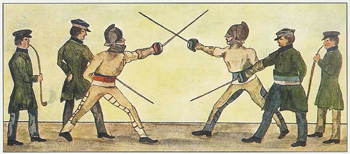 Academic fencing of Dorpat fraternity students, 1820s
Academic fencing of Dorpat fraternity students, 1820s
|
Peace, war, and masculinities in antebellum America
In this project I examine two related phenomena in the early nineteenth century: the vigorous debates between Americans over the nature of national society and the memory of the Revolutionary War, and rapid changes in the American gender system, especially the elaboration of publicly admired forms of manliness. I believe that understanding the many masculinities expressed during the age of reform can help historians better comprehend an antebellum public culture that increasingly put a premium on fierce, muscular debate and uncompromising political and cultural leaders.
This project began with research on the little-known peace movement of the antebellum era—particularly its leader, a retired ship’s captain named William Ladd. In his writings and speeches, Ladd sought to model a new form of gentle manliness that eschewed all forms of aggression, both physical and rhetorical. This brought him into conflict with other social reformers of the day, most notably the abolitionist William Lloyd Garrison, who dismissed Ladd’s manly stance as wholly ineffective and a vestige of an elitist American past. I am now expanding the contours of the project to explore the emergence of highly abrasive rhetorics, aggressive war hero-politicians such as Andrew Jackson, and a new antebellum assessment of the Revolution. |
 Academic fencing of Dorpat fraternity students, 1820s
Academic fencing of Dorpat fraternity students, 1820s



